The Federal Reserve Bank of Kansas City released it third quarter Ag Finance Databook last Friday and its headline read “Large Scale Financing Drives Ag Lending Activity Higher.”
In summarizing its findings, the report said, “Large operating loans made by large agricultural banks led to a significant increase in farm lending in the third quarter of 2018. A sharp increase in the volume of loans exceeding $1 million was a primary contributor to the increase in non-real estate farm lending. In particular, a majority of the increase was supported by loans used to fund current operating expenses. The increase in the size of loans also sharply increased the share of agricultural lending at large banks while interest rates on farm loans continued to trend upward.”
The data is based on the National Survey of Terms of Lending to Farmers. Total volume of non-real estate farm loans was more than 30% higher than a year ago and, unfortunately, a very small portion of the total lending was for ag machinery. The report authors say, “The sharp growth in farm lending followed steady increases earlier in 2018 and represents the largest annual percentage increase in the third quarter since 2002. The typical seasonal pattern of reduced loan volumes from the second quarter to the third quarter also was much less pronounced. The volume of non-real estate loans decreased less than 3% from the previous quarter, compared with an average decline over the last 10 years of 14%.”
It would appear that producers are looking at or anticipating significant cashflow issues going into the last quarter of 2018. What makes the current trend stand out is the increasing size of the loans. According to the report, from 2008-12 the volume of individual loans larger than $1 million totaled an average of about $350 million, or 25% of total non-real estate lending. During the next 5 year period, 2013-17, the average volume of loans larger than $1 million grew only slightly but remained unchanged as a share of total loan volumes. In the third quarter, the volume of loans larger than $1 million nearly doubled and accounted for almost 40% of total non-real estate lending during the reporting period.
One good sign is the delinquency rates on non-real estate have remained low. At the same time, the delinquency rates on farm real estate loans continued to trend higher “at a modest pace and were higher than the rate of delinquencies on all bank loans for the first time in nearly 20 years,” say the report authors.
While no one is yet is sounding the alarm, these trends in farm lending bear watching.
What’s also interesting is the demand for non-real estate loans increased in four of the five Federal Reserve Districts that comprise most of the U.S. Breadbasket (Chicago, Kansas City, Minneapolis and St. Louis). Meanwhile, the Dallas Federal Reserve Bank is reporting that demand for non-real estate farm loans in its coverage area continues to decline.
The lead author of the Ag Finance Databook report, Nathan Kauffman, vice president and Omaha Branch Executive of the Kansas Federal Reserve Bank, will be the featured speaker at Ag Equipment Intelligence’s Nov. 9 webinar on trends in agriculture lending and credit conditions.








Post a comment
Report Abusive Comment